Design of Novel Haptens and Development of Monoclonal Antibody-Based Immunoassays for the Simultaneous Detection of Tylosin and Tilmicosin in Milk and Water Samples
Abstract
1. Introduction
2. Materials and Methods
2.1. Materials and Instruments
2.2. Synthesis of Haptens and Antigens
2.3. Immunization and Monoclonal Antibodies
2.4. icELISA Protocol
2.5. Optimization of icELISA Condition
2.6. Preparation and Elimination of Matrix Effect in Samples for icELISA
2.7. Comparison of icELISA with HPLC-MS/MS
2.8. Molecular Simulation
3. Results and Discussion
3.1. Design and Screening of the Haptens
3.2. Preparation and Characterization of Monoclonal Antibodies
3.3. The Standard Curve for icELISA
3.4. Specificity of icELISA
3.5. Elimination of Matrix Effect in Samples of icELISA
3.6. Test in Spiked Samples and Real Positive Sample
4. Conclusions
Supplementary Materials
Author Contributions
Funding
Conflicts of Interest
Ethical Approval
References
- Vicca, J.; Maes, D.; Jonker, L.; De Kruif, A.; Haesebrouck, F. Efficacy of in-feed medication with tylosin for the treatment and control of Mycoplasma hyopneumoniae infections. Vet. Rec. 2005, 156, 606–610. [Google Scholar] [CrossRef] [PubMed]
- Song, Y.; Song, S.; Liu, L.; Kuang, H.; Guo, L.; Xu, C. Simultaneous detection of tylosin and tilmicosin in honey using a novel immunoassay and immunochromatographic strip based on an innovative hapten. Food Agric. Immunol. 2016, 27, 314–328. [Google Scholar] [CrossRef]
- Wei, S.; Le, T.; Chen, Y.; Xu, J.; He, H.; Niu, X.; Luo, J. Time-resolved fluoroimmunoassay for quantitative determination of tylosin and tilmicosin in edible animal tissues. Chin. Sci. Bull. 2013, 58, 1838–1842. [Google Scholar] [CrossRef]
- Jordan, F.T.W.; Forrester, C.A.; Hodge, A.; Reeve-Johnson, L.G. The comparison of an aqueous preparation of tilmicosin with tylosin in the treatment of Mycoplasma gallisepticum infection of turkey poults. Avian Dis. 1999, 43, 521–525. [Google Scholar] [CrossRef]
- Li, H.S.; Zhang, J.Y.; Zhou, X.Z.; Li, J.Y.; Li, J.S.; Miao, X.L.; Zhang, Z.F. Comparison of antibacterial effect of tilmicosin with tylosin on some commonly pathogenic bacteria of domestic animals. Prog. Vet. Med. 2006, 27, 94–96. [Google Scholar] [CrossRef]
- Bicer, E.; Ozdemir, S. Voltammetric and spectroscopic studies on the interaction of tilmicosin with bovine serum albumin at different pHs. J. Electroanal. Chem. 2011, 657, 128–134. [Google Scholar] [CrossRef]
- Arsic, B.; Barber, J.; Cikos, A.; Mladenovic, M.; Stankovic, N.; Novak, P. 16-membered macrolide antibiotics: A review. Int. J. Antimicrob. Agents 2017, 51, 283–298. [Google Scholar] [CrossRef]
- Jones, P.W.; Tarrant, M.E. The effect of various factors on the efficacy of tylosin as a growth promoter in clinically healthy pigs. Anim. Prod. 2010, 34, 115–121. [Google Scholar] [CrossRef]
- Cusack, P.M.V. Effect of mass medication with antibiotics at feedlot entry on the health and growth rate of cattle destined for the Australian domestic market. Aust. Vet. J. 2004, 82, 154–156. [Google Scholar] [CrossRef]
- Avci, T.; Elmas, M. Milk and blood pharmacokinetics of tylosin and tilmicosin following parenteral administrations to cows. Sci. World J. 2014, 2014, 869096. [Google Scholar] [CrossRef]
- Sarmah, A.K.; Meyer, M.T.; Boxall, A.B.A. A global perspective on the use, sales, exposure pathways, occurrence, fate and effects of veterinary antibiotics (VAs) in the environment. Chemosphere 2006, 65, 725–759. [Google Scholar] [CrossRef] [PubMed]
- Wang, X.; Guo, R.; Ma, B.; Liao, X.; Wu, Y. Excretion of sulfamethazine, chlortetracycline, tylosin and their main metabolites in pig manure. Chin. J. Vet. Sci. 2014, 34, 269–274. [Google Scholar] [CrossRef]
- Hao, H.; Yao, J.; Wu, Q.; Wei, Y.; Dai, M.; Iqbal, Z.; Wang, X.; Wang, Y.; Huang, L.; Chen, D.; et al. Microbiological toxicity of tilmicosin on human colonic microflora in chemostats. Regul. Toxicol. Pharmacol. 2015, 73, 201–208. [Google Scholar] [CrossRef] [PubMed]
- Gautier-Bouchardon, A.V.; Reinhardt, A.K.; Kobisch, M.; Kempf, I. In vitro development of resistance to enrofloxacin, erythromycin, tylosin, tiamulin and oxytetracycline in Mycoplasma gallisepticum, Mycoplasma iowae and Mycoplasma synoviae. Vet. Microbiol. 2002, 88, 47–58. [Google Scholar] [CrossRef]
- Wang, H.; Ren, L.; Yu, X.; Hu, J.; Chen, Y.; He, G.; Jiang, Q. Antibiotic residues in meat, milk and aquatic products in Shanghai and human exposure assessment. Food Control. 2017, 80, 217–225. [Google Scholar] [CrossRef]
- Ministry of Agriculture. The Maximum Residue Limits of Veterinary Drugs in Animal Foods; No. 235 Bulletin; Ministry of Agriculture of the People’s Republic of China: Beijng, China, 29 June 2008.
- Council Regulation (EC) No 2821/98 of 17 December 1998 amending, as regards withdrawal of the authorisation of certain antibiotics, Directive 70/524/EEC concerning additives in feeding-stuffs. Off. J. Eur. Communities 1998, L351, 4–5.
- Chebira, B.; Boultif, L.; Agabou, A.; Mekroud, A. Validation of a high performance liquid chromatography (HPLC) method to detect and quantify some antibiotics residues in honey. Adv. Anim. Vet. Sci. 2015, 3, 295–301. [Google Scholar] [CrossRef]
- Jank, L.; Martins, M.T.; Arsand, J.B.; Campos Motta, T.M.; Hoff, R.B.; Barreto, F.; Pizzolato, T.M. High-throughput method for macrolides and lincosamides antibiotics residues analysis in milk and muscle using a simple liquid-liquid extraction technique and liquid chromatography-electrospray-tandem mass spectrometry analysis (LC-MS/MS). Talanta 2015, 144, 686–695. [Google Scholar] [CrossRef]
- Yibar, A.; Özcan, A.; Karaca, M.Y. Determination of erythromycin, spiramycin, tilmicosin and tylosin in animal feedingstuffs by liquid chromatography-tandem mass spectrometry. Kafkas Üniversitesi Vet. Fakültesi Derg. 2014, 20, 439–444. [Google Scholar] [CrossRef]
- Wang, Z.; Beier, R.C.; Shen, J. Immunoassays for the detection of macrocyclic lactones in food matrices—A review. TrAC-Trends Anal. Chem. 2017, 92, 42–61. [Google Scholar] [CrossRef]
- Liu, A.; Anfossi, L.; Shen, L.; Li, C.; Wang, X. Non-competitive immunoassay for low-molecular-weight contaminant detection in food, feed and agricultural products: A mini-review. Trends Food Sci. Technol. 2018, 71, 181–187. [Google Scholar] [CrossRef]
- Du, B.; Wen, F.; Guo, X.; Zheng, N.; Zhang, Y.; Li, S.; Zhao, S.; Liu, H.; Meng, L.; Xu, Q.; et al. Evaluation of an ELISA-based visualization microarray chip technique for the detection of veterinary antibiotics in milk. Food Control. 2019, 106, 106713. [Google Scholar] [CrossRef]
- Li, M.; Hua, X.; Ma, M.; Liu, J.; Zhou, L.; Wang, M. Detecting clothianidin residues in environmental and agricultural samples using rapid, sensitive enzyme-linked immunosorbent assay and gold immunochromatographic assay. Sci. Total Environ. 2014, 499, 1–6. [Google Scholar] [CrossRef] [PubMed]
- Zhang, J.K.; Liu, J.X.; Wang, L.L.; Chai, L.; Wang, J.P. Production of the monoclonal antibody against tylosin for immunoassay of macrolide antibiotics in milk. J. Environ. Sci. Health Part B-Pestic. 2012, 47, 876–882. [Google Scholar] [CrossRef]
- Le, T.; He, H.; Niu, X.; Chen, Y.; Xu, J. Development of an immunochromatographic assay for detection of tylosin and tilmicosin in muscle, liver, fish and eggs. Food Agric. Immunol. 2013, 24, 467–480. [Google Scholar] [CrossRef]
- Zhang, J.K.; Qi, Y.H.; Liu, J.X.; Wang, J.P. Heterologous immunoassay for screening macrolide antibiotics residues in milk based on the monoclonal antibody of tylosin. Food Agric. Immunol. 2013, 24, 419–431. [Google Scholar] [CrossRef]
- Le, T.; Zhu, L.; Yang, X. A quantum dot-based immunoassay for screening of tylosin and tilmicosin in edible animal tissues. Food Addit. Contam. Part A-Chem. Anal. Control. Expo. Risk Assess. 2015, 32, 719–724. [Google Scholar] [CrossRef]
- Yao, C.; Xu, Z.; Wang, H.; Zhu, F.; Luo, L.; Yang, J.; Sun, Y.; Lei, H.; Tian, Y.; Shen, Y. High affinity antibody based on a rationally designed hapten and development of a chemiluminescence enzyme immunoassay for quantification of Alternariol in fruit Juice, maize and flour. Food Chem. 2019, 283, 359–366. [Google Scholar] [CrossRef]
- Yao, C.; Yang, J.; Xu, Z.; Wang, H.; Lei, H.; Sun, Y.; Tian, Y.; Shen, Y. Indirect competitive enzyme-linked immunosorbent assay for detection of tylosin in milk and water samples. Chin. J. Anal. Chem. 2018, 46, 1275–1281. [Google Scholar] [CrossRef]
- Chen, Z.J.; Fu, H.J.; Luo, L.; Sun, Y.M.; Yang, J.Y.; Zeng, D.P.; Shen, Y.D.; Xu, Z.L. Development of competitive indirect ELISAs with a flexible working range for the simple quantification of melatonin in medicinal foods. Anal. Methods 2017, 9, 1617–1626. [Google Scholar] [CrossRef]
- Köhler, G.; Milstein, C. Continuous cultures of fused cells secreting antibody of predefined specificity. Nature 1975, 256, 495–497. [Google Scholar] [CrossRef] [PubMed]
- Determination of Spiramycin, Pyrimidin, Oleandomycin, Tilmicosin, Eythromycin, And Tylosin in Milk and Milk Powder by Liquid Chromatography-Tandem Mass Spectrometry; GB/T 22988-2008; National Standards of the People’s Republic of China: Shenzhen, China, December 2008.
- Xu, Z.; Shen, Y.; Sun, Y.; Campbell, K.; Tian, Y.; Zhang, S.; Lei, H.; Jiang, Y. Novel hapten synthesis for antibody production and development of an enzyme-linked immunosorbent assay for determination of furaltadone metabolite 3-amino-5-morpholinomethyl-2-oxazolidinone (AMOZ). Talanta 2013, 103, 306–313. [Google Scholar] [CrossRef] [PubMed]
- Lei, H.; Shen, Y.; Song, L.; Yang, J.; Chevallier, O.P.; Haughey, S.A.; Wang, H.; Sun, Y.; Elliott, C.T. Hapten synthesis and antibody production for the development of a melamine immunoassay. Anal. Chim. Acta 2010, 665, 84–90. [Google Scholar] [CrossRef] [PubMed]
- Wang, F.; Cai, J.; Eremin, S.A.; Xiao, Z.; Shen, Y.; Tian, Y.; Xu, Z.; Yang, J.; Lei, H.; Sun, Y.; et al. Fluorescence Polarization Immunoassay for Alternaria Mycotoxin Tenuazonic Acid Detection and Molecular Modeling Studies of Antibody Recognition. Food Anal. Methods 2018, 11, 2455–2462. [Google Scholar] [CrossRef]
- He, F.; Tian, Y.; Xu, Z.; Luo, L.; Yang, J.; Wang, H.; Sun, Y.; Du, Q.; Shen, Y. Development of an immunochromatographic assay as a screen for detection of total phthalate acid esters in cooking oil. J. Toxicol. Environ. Health-Part A-Curr. Issues 2018, 81, 80–88. [Google Scholar] [CrossRef]
- Song, J.; Wang, R.M.; Wang, Y.Q.; Tang, Y.R.; Deng, A.P. Hapten design, modification and preparation of artificial antigens. Chin. J. Anal. Chem. 2010, 38, 1211–1218. [Google Scholar] [CrossRef]
- Goodrow, M.H.; Hammock, B.D. Hapten design for compound-selective antibodies: ELISAS for environmentally deleterious small molecules. Anal. Chim. Acta 1998, 376, 83–91. [Google Scholar] [CrossRef]
- Shen, Y.D.; Wang, Y.; Zhang, S.W.; Xiao, Z.L.; Sun, Y.M.; Bu, X.Z.; Gu, L.Q. Design and efficient synthesis of novel haptens and complete antigens for the AOZ, a toxic metabolite of furazolidone. Chin. Chem. Lett. 2007, 18, 1490–1492. [Google Scholar] [CrossRef]
- Liu, F.; Chen, Z.; Shen, Y.; Sun, Y.; Yang, J.; Wang, H.; Xu, Z. Hapten synthesis and production of specific antibody against 3-amino-5-morpholinomethyl-2-oxazolidone for immunoassay without derivatisation. Food Agric. Immunol. 2018, 29, 332–345. [Google Scholar] [CrossRef]
- He, F.; Zou, T.; Yang, J.; Wang, H.; Deng, L.; Tian, Y.; Xu, Z.; Sun, Y.; Lei, H.; Tan, X.; et al. Development of a skeleton-specific antibody and Au nanoparticle-based immunochromatographic sensor for simultaneous detection of various tadalafil adulterants in health food. Food Agric. Immunol. 2019, 30, 349–368. [Google Scholar] [CrossRef]
- Paek, S.; Lee, S.; Cho, J.; Kim, Y. Development of Rapid One-Step Immunochromatographic Assay. Methods 2000, 22, 53–60. [Google Scholar] [CrossRef]
- Wang, Z.; Yu, X.; Ma, L.; Liu, H.; Ding, S.; Wang, Z.; Zhang, X.; Shen, J.; Wen, K. Preparation of high affinity antibody for ribavirin with new haptens and residue analysis in chicken muscle, eggs and duck muscle. Food Addit. Contam. Part A 2018, 35, 1247–1256. [Google Scholar] [CrossRef]
- Liu, A. Effects of pretreatment of food samples on residues of veterinary drug residues. Mod. Food 2017, 2017, 49–50. [Google Scholar] [CrossRef]
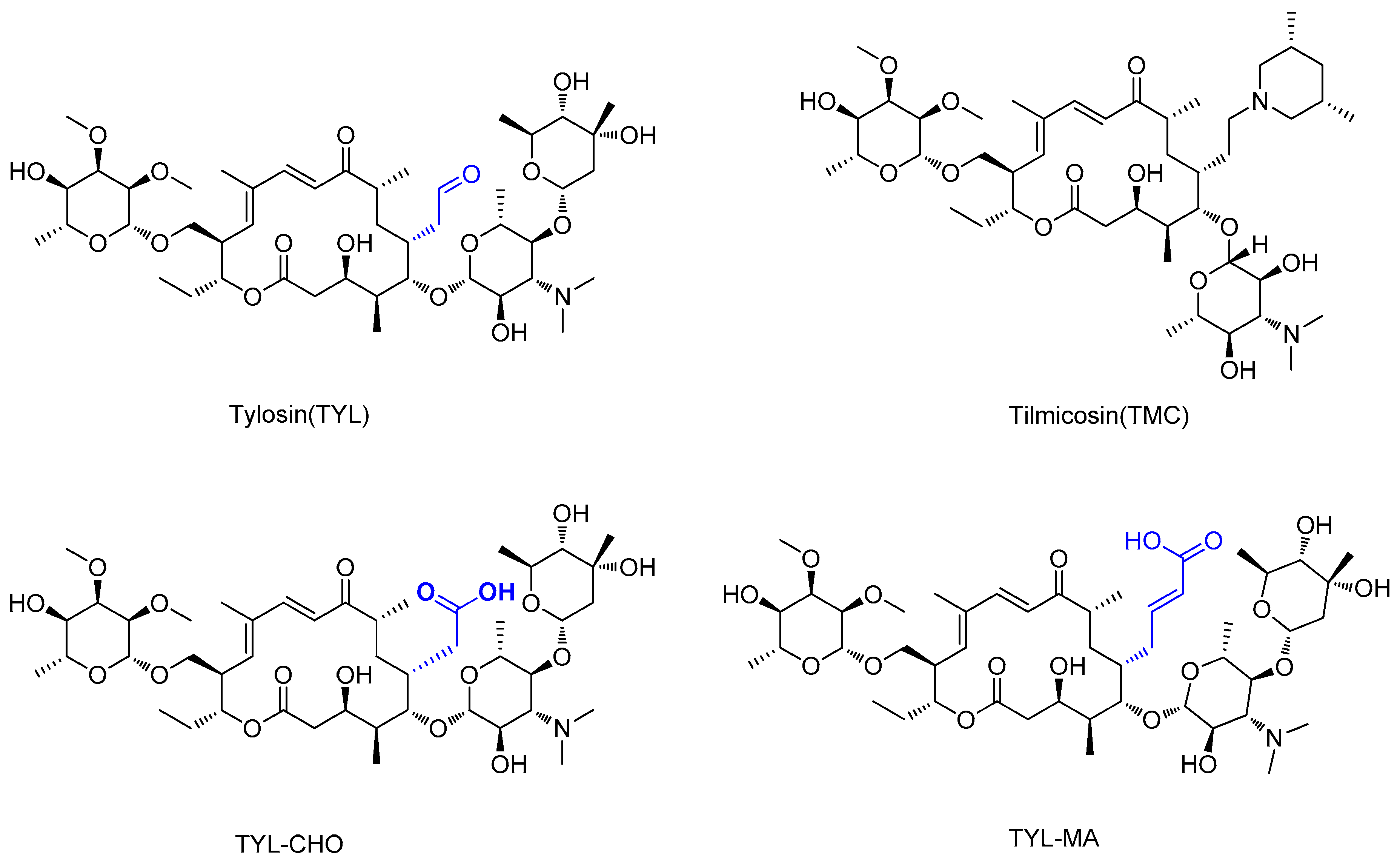
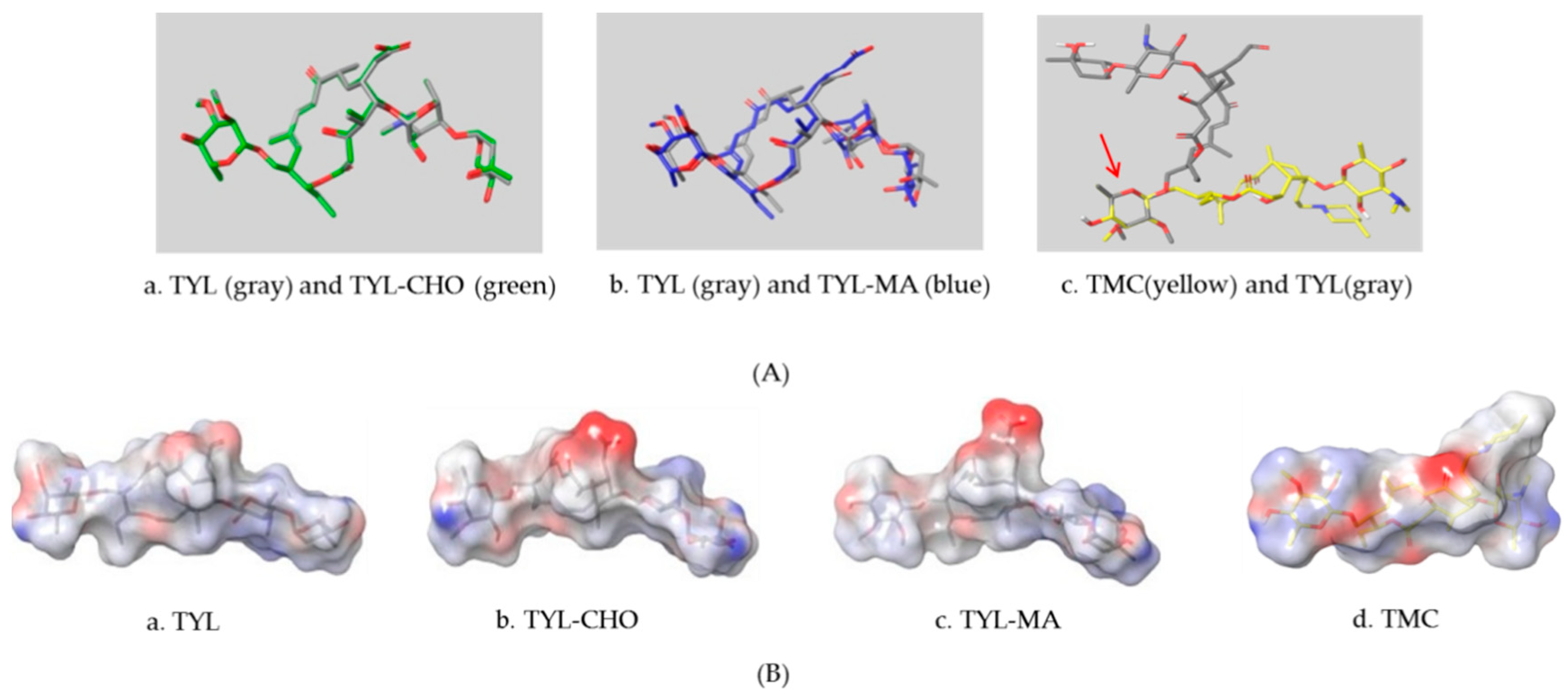
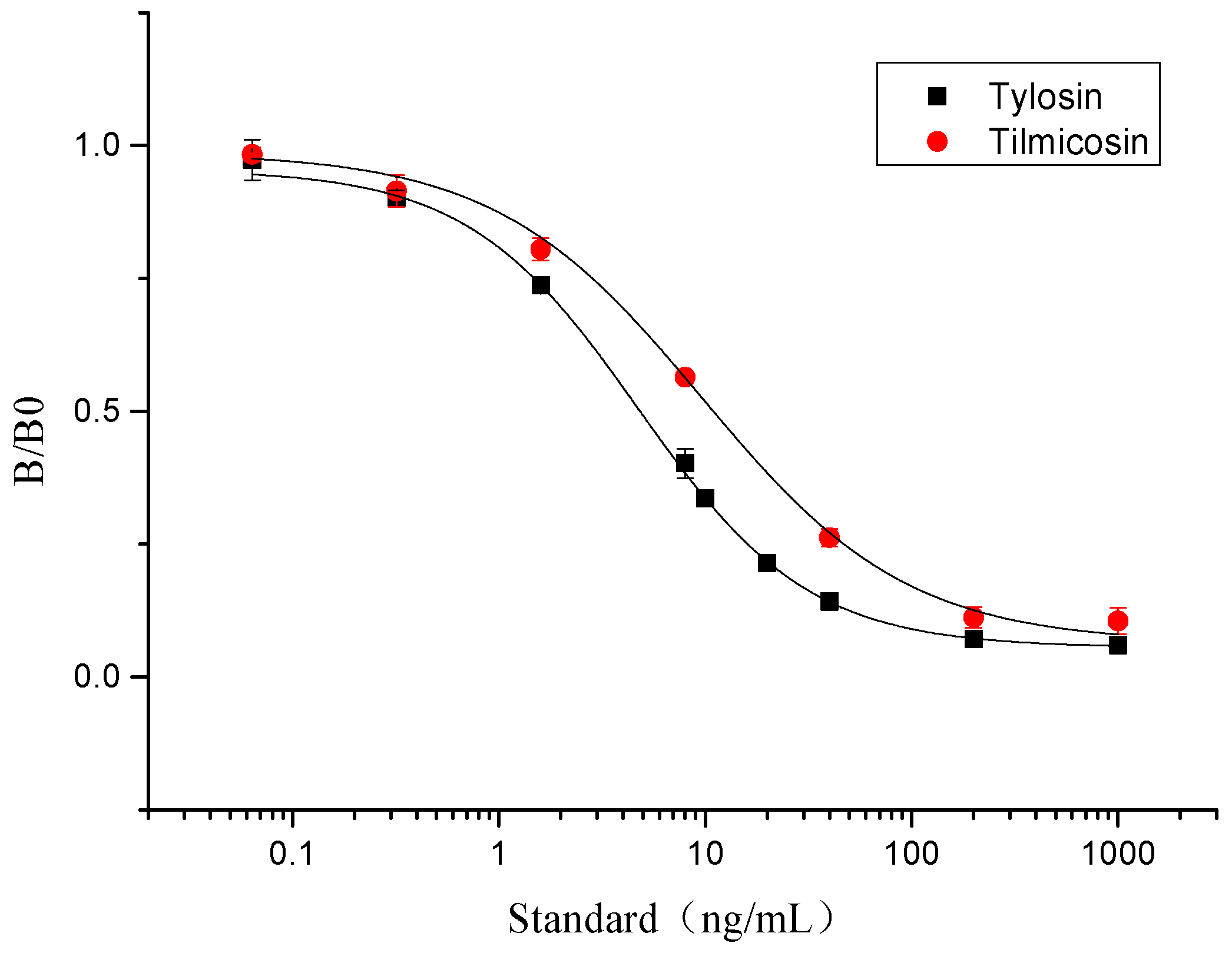
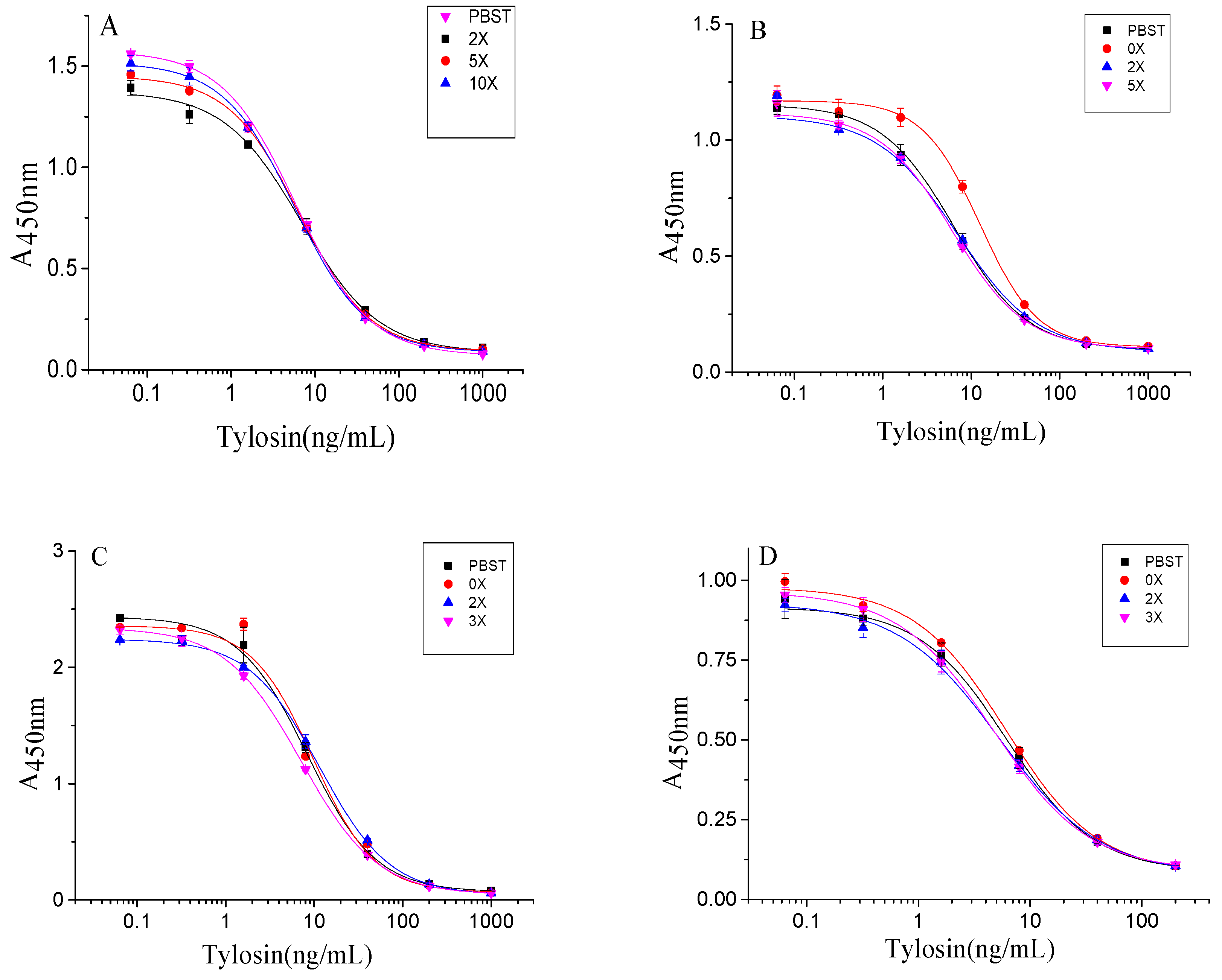
| Immunogen | TYL-CHO-BSA | TYL-MA-BSA | ||||
|---|---|---|---|---|---|---|
| Coating Antigens | Titer a (103) | Inhibition b of TYL (%) | Inhibition of TMC (%) | Titer (103) | Inhibition of TYL (%) | Inhibition of TMC (%) |
| TYL-CHO-OVA | 16 | 89 | 78 | 0 | 0 | 0 |
| TYL-MA-OVA | 0 | 0 | 0 | 0 | 0 | 0 |
| Compound | Structure | icELISA | |
|---|---|---|---|
| IC50 (ng/mL) | CR * (%) | ||
| Tylosin |  | 4.7 | 100 |
| Tilmicosin |  | 9.6 | 49.0 |
| Erythromycin |  | >2000 | <0.1 |
| Roxithromycin | 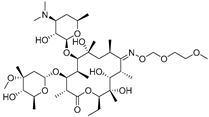 | >2000 | <0.1 |
| Spiramycin |  | >2000 | <0.1 |
| Acetylspiramycin | 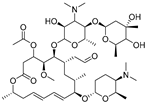 | >2000 | <0.1 |
| Abamectin | 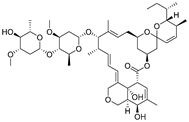 | >2000 | <0.1 |
| Azithromycin | 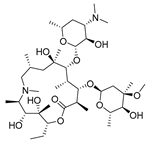 | >2000 | <0.1 |
| Enrofloxacin |  | >2000 | <0.1 |
| Pefloxacin |  | >2000 | <0.1 |
| mAbs | Titer (103) | IC50 (ng/mL, Tylosin) | IC50 (ng/mL, Tilmicosin) | Cross-React with Tilmicosin (%) |
|---|---|---|---|---|
| L01 | 1.6 | 6.2 | 16.1 | 38.5 |
| L02 | 1.6 | 5.0 | 8.5 | 58.8 |
| L03 | 1.6 | 5.2 | 9.2 | 56.4 |
| L04 | 1.6 | 5.9 | 21.5 | 26.9 |
| icELISA | HPLC-MS/MS | |||||||
|---|---|---|---|---|---|---|---|---|
| Samples | Spiked | Spiked level (ng/mL) | Measured (ng/mL) (mean ± SD b) | Recoveries (%) | CV (%) | Measured (ng/mL) (mean ± SD) | Recoveries (%) | CV (%) |
| Milk | Tylosin | 25 | 21.6 ± 1.6 | 86.4 | 7.4 | 20.16 ± 0.41 | 80.6 | 2.0 |
| 50 | 41.8 ± 6.0 | 83.5 | 14.4 | 34.15 ± 2.67 | 68.3 | 7.8 | ||
| 100 | 88.4 ± 5.4 | 88.4 | 6.1 | 78.61 ± 0.71 | 78.6 | 0.9 | ||
| Tilmicosin | 25 | 24.7 ± 2.2 | 98.7 | 8.9 | 28.67 ± 0.17 | 114.7 | 0.6 | |
| 50 | 54.8 ± 2.0 | 109.5 | 3.6 | 55.05 ± 0.71 | 110.1 | 1.3 | ||
| 100 | 83.0 ± 3.5 | 83.0 | 4.2 | 114.35 ± 2.66 | 114.4 | 2.3 | ||
| Drinking water | Tylosin | 5 | 4.6 ± 0.2 | 92.2 | 4.3 | 3.61 ± 0.41 | 72.1 | 11.3 |
| 10 | 7.6 ± 0.2 | 76.4 | 2.6 | 6.78 ± 0.91 | 67.8 | 13.4 | ||
| 20 | 19.8 ± 0.6 | 99.2 | 3.0 | 14.52 ± 1.18 | 72.6 | 8.2 | ||
| Tilmicosin | 5 | 4.4 ± 0.6 | 87.0 | 13.6 | 3.40 ± 0.27 | 67.9 | 7.9 | |
| 10 | 9.1 ± 0.1 | 91.1 | 1.1 | 6.65 ± 0.03 | 66.5 | 0.5 | ||
| 20 | 17.2 ± 1.4 | 85.9 | 8.1 | 14.11 ± 0.81 | 70.6 | 5.7 | ||
| Tap water | Tylosin | 5 | 4.1 ± 0.1 | 81.9 | 2.4 | 5.44 ± 0.01 | 108.7 | 0.1 |
| 10 | 8.3 ± 0.3 | 82.8 | 3.6 | 11.04 ± 0.72 | 110.4 | 6.6 | ||
| 20 | 17.7 ± 0.7 | 88.2 | 4.0 | 22.85 ± 0.18 | 114.3 | 0.8 | ||
| Tilmicosin | 5 | 4.2 ± 0.3 | 84.5 | 7.1 | 3.21 ± 0.14 | 64.3 | 4.3 | |
| 10 | 8.0 ± 1.1 | 80.0 | 13.8 | 6.65 ± 0.21 | 66.5 | 3.2 | ||
| 20 | 18.8 ± 2.1 | 94.0 | 11.2 | 14.66 ± 0.45 | 73.3 | 3.1 | ||
| Environmental water | Tylosin | 5 | 3.9 ± 0.1 | 77.2 | 2.6 | 4.29 ± 0.13 | 85.9 | 3.0 |
| 10 | 8.8 ± 0.3 | 87.9 | 3.4 | 9.57 ± 0.68 | 95.7 | 7.1 | ||
| 20 | 17.0 ± 0.2 | 85.1 | 1.2 | 18.37 ± 1.36 | 91.8 | 7.4 | ||
| Tilmicosin | 5 | 5.1 ± 0.1 | 101.7 | 2.0 | 3.24 ± 0.13 | 64.9 | 4.1 | |
| 10 | 7.9 ± 0.1 | 79.2 | 1.3 | 8.10 ± 0.30 | 81.0 | 3.7 | ||
| 20 | 18.1 ± 1.2 | 90.3 | 6.6 | 15.20 ± 1.08 | 76.0 | 7.1 | ||
| Sample | Number | icELISA (ng/mL) (mean ± SD b) | HPLC-MS/MS (ng/mL) (mean ± SD) | |
|---|---|---|---|---|
| TYL/TMC | TYL | TMC | ||
| Milk | 1 | 17.9 ± 0.9 | 18.86 ± 0.86 | ND c |
| 2 | 17.7 ± 0.4 | 20.58 ± 1.06 | ND c | |
| 3 | 9.4 ± 0.9 | 9.21 ± 0.07 | ND c | |
| Environmental water | 4 | 0.5 ± 0.1 | ND c | 1.35 ± 0.15 |
| 5 | 0.7 ± 0.1 | ND c | 1.84 ± 0.16 | |
| 6 | 0.9 ± 0.1 | ND c | 1.83 ± 0.05 | |
| 7 | 1.2 ± 0.1 | 0.11 ± 0.01 | 3.18 ± 0.09 | |
| 8 | 8.3 ± 1.1 | 10.04 ± 0.23 | ND c | |
| 9 | 6.2 ± 0.5 | 7.24 ± 0.42 | ND c | |
| 10 | 4.6 ± 0.1 | 4.93 ± 0.13 | 2.27 ± 0.07 | |
| 11 | 18.1 ± 0.6 | 20.38 ± 0.61 | ND c | |
© 2019 by the authors. Licensee MDPI, Basel, Switzerland. This article is an open access article distributed under the terms and conditions of the Creative Commons Attribution (CC BY) license (http://creativecommons.org/licenses/by/4.0/).
Share and Cite
Huang, J.-X.; Yao, C.-Y.; Yang, J.-Y.; Li, Z.-F.; He, F.; Tian, Y.-X.; Wang, H.; Xu, Z.-L.; Shen, Y.-D. Design of Novel Haptens and Development of Monoclonal Antibody-Based Immunoassays for the Simultaneous Detection of Tylosin and Tilmicosin in Milk and Water Samples. Biomolecules 2019, 9, 770. https://doi.org/10.3390/biom9120770
Huang J-X, Yao C-Y, Yang J-Y, Li Z-F, He F, Tian Y-X, Wang H, Xu Z-L, Shen Y-D. Design of Novel Haptens and Development of Monoclonal Antibody-Based Immunoassays for the Simultaneous Detection of Tylosin and Tilmicosin in Milk and Water Samples. Biomolecules. 2019; 9(12):770. https://doi.org/10.3390/biom9120770
Chicago/Turabian StyleHuang, Jian-Xin, Chan-Yuan Yao, Jin-Yi Yang, Zhen-Feng Li, Fan He, Yuan-Xin Tian, Hong Wang, Zhen-Lin Xu, and Yu-Dong Shen. 2019. "Design of Novel Haptens and Development of Monoclonal Antibody-Based Immunoassays for the Simultaneous Detection of Tylosin and Tilmicosin in Milk and Water Samples" Biomolecules 9, no. 12: 770. https://doi.org/10.3390/biom9120770
APA StyleHuang, J.-X., Yao, C.-Y., Yang, J.-Y., Li, Z.-F., He, F., Tian, Y.-X., Wang, H., Xu, Z.-L., & Shen, Y.-D. (2019). Design of Novel Haptens and Development of Monoclonal Antibody-Based Immunoassays for the Simultaneous Detection of Tylosin and Tilmicosin in Milk and Water Samples. Biomolecules, 9(12), 770. https://doi.org/10.3390/biom9120770






